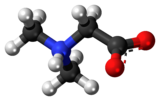Dimethylglycine
 |
|
 |
|
| Names | |
|---|---|
|
IUPAC name
2-(Dimethylamino)acetic acid
|
|
| Other names
N,N-Dimethylglycine
|
|
| Identifiers | |
|
3D model (Jmol)
|
|
| 3DMet | B00224 |
| 1700261 | |
| ChEBI | |
| ChemSpider | |
| DrugBank | |
| ECHA InfoCard | 100.012.971 |
| EC Number | 214-267-8 |
| 82215 | |
| KEGG | |
| MeSH | dimethylglycine |
|
PubChem CID
|
|
| RTECS number | MB9865000 |
|
|
|
|
| Properties | |
| C4H9NO2 | |
| Molar mass | 103.12 g·mol−1 |
| Appearance | White crystals |
| Odor | Odourless |
| Density | 1.069 g/mL |
| Melting point | 178 to 182 °C (352 to 360 °F; 451 to 455 K) |
| Boiling point | 175.2 °C (347.4 °F; 448.3 K) |
| Hazards | |
| GHS pictograms |  |
| GHS signal word | WARNING |
| H302 | |
| Lethal dose or concentration (LD, LC): | |
|
LD50 (median dose)
|
>650 mg kg−1(oral, rat) |
| Related compounds | |
|
Related alkanoic acids
|
|
|
Related compounds
|
Dimethylacetamide |
|
Except where otherwise noted, data are given for materials in their standard state (at 25 °C [77 °F], 100 kPa).
|
|
|
|
|
| Infobox references | |
Dimethylglycine is a derivative of the amino acid glycine with the structural formula (CH3)2NCH2COOH. It can be found in beans and liver. It can be formed from trimethylglycine upon the loss of one of its methyl groups. It is also a byproduct of the metabolism of choline.
When DMG was first discovered, it was referred to as Vitamin B16, but, unlike true B vitamins, deficiency of DMG in the diet does not lead to any ill-effects and it is synthesized by the human body in the citric acid (or Krebs) cycle meaning it does not meet the definition of a vitamin.
Dimethylglycine has been suggested for use as an athletic performance enhancer, immunostimulant, and a treatment for autism, epilepsy, or . Published studies on the subject have shown little to no difference between DMG treatment and placebo in autism spectrum disorders.
Dimethylglycine has been found to act as an agonist of the glycine site of the NMDA receptor.
This compound is commercially available as the free form amino acid, and as the hydrochloride salt [2491-06-7 ]. DMG may be prepared by the alkylation of glycine via the Eschweiler–Clarke reaction. In this reaction, glycine is treated with aqueous formaldehyde in formic acid that serves as both solvent and reductant. Hydrochloric acid is added thereafter to give the hydrochloride salt. The free amino acid may been obtained by neutralization of the acid salt, which has been performed with silver oxide.
...
Wikipedia
